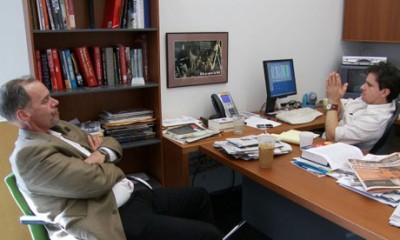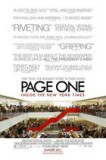| Reviews & Columns |
|
Reviews DVD TV on DVD Blu-ray 4K UHD International DVDs In Theaters Reviews by Studio Video Games Features Collector Series DVDs Easter Egg Database Interviews DVD Talk Radio Feature Articles Columns Anime Talk DVD Savant Horror DVDs The M.O.D. Squad Art House HD Talk Silent DVD
|
DVD Talk Forum |
|
|
| Resources |
|
DVD Price Search Customer Service #'s RCE Info Links |
|
Columns
|
|
|
Page One: Inside the New York Times

David Carr, media columnist for the New York Times, says that when he ends an interview, "most subjects have a question of their own: What's gonna happen to the New York Times?" It's a question that is compellingly asked (if not really answered, because it honestly can't be) by Andrew Rossi's new documentary Page One: Inside the New York Times, a look at the day-to-day operation of a venerable organization that is doing its very best not to go the way of the dinosaur.
Rossi and his crew spent roughly a year in the Times newsroom--a year dominated by the continuing specter of the newspaper business's death. In a brisk opening montage, news clips fill in the blanks: papers going under, massive lay-offs, shrinking revenues. The film--aided by media observers and figures including Gay Talese, David Remnick, Katrina vandan Heuvel, and Carl Bernstein--attempts (mostly successfully) to understand and explain why the newspaper business is in the state it's in, but does so within the narrative of daily events unfolding at the paper.
We get a sense of how things work: the 10:30am and 4pm editorial meetings (at which editors fight for placement on A1), building big stories, the oft-times strained attempts to adjust and adapt to a changing marketplace by using new media, the attempt to play catch-up after, in Carr's words, "decades of organizational hubris about our own excellence and our own dominance." It is a year dominated by WikiLeaks, an organization that challenges the traditional model; after their explosive first video is released on the Internet, Times executive editor Bill Keller dismisses comparisons with the Pentagon Papers, because "WikiLeaks did not need the Times. Daniel Ellsberg did." (In a public interview, Ellsberg says that if he got ahold of the Pentagon Papers today, he'd buy a scanner and send them to the blogs.)
Later, the Times (and three other papers) works with WikiLeaks to release a series of documents, leading to a lively newsroom debate about whether the organization is a source or a partner. Whatever the case may be, it becomes clearer that there is still a place for the Times--the WikiLeaks documents and (later) diplomatic cables provide newsworthy information to the paper, which in turn lends Assange and WikiLeaks a sheen of respectability.
Throughout the film, we see other methods of adaptation--the hiring of media blogger Brian Stelter, the incorporation of blogs and video, the waves made by the iPad, the introduction of the Times paywall. And we see the battles the once-untouchable paper still fights--questions of credibility in the wake of Judith Miler and Jayson Blair, the rise of aggregators like Gawker and Huffington Post, and the issue of their own relevance. That last one is best mounted at a panel debate by Vanity Fair columnist Michael Wolff, though David Carr uses a well-chosen visual aide to quickly and efficiently take his argument apart.
Carr is, to a degree, the hero of the piece--an odd but talented writer and investigator, engaging yet tough. A reformed drug addict and single father (walking the street at night talking about his past, he shrugs, "That was another life, that was another guy..." before pointing to a passed-out junkie on the sidewalk and adding, "That guy"), his no-nonsense personality takes over one of the film's best scenes, an uncomfortable yet riveting interview with the editors of Vice magazine that goes off the rails when they off-handedly denigrate Carr's paper.
In the third act, the documentary is dominated by the collapse of the Tribune company and by Carr's in-depth Times investigation of it--with both Rossi and Carr analyzing how and why it sank, to the chagrin of the article's subject. Throughout Page One, but particularly in these scenes, the picture functions as a snapshot of not just what's happening at the Times, but of the entire media landscape.
Rossi shoots in a smooth, professional style, the stylish HD video photography capturing crisp images and clean compositions. It's not a flashy movie, but it moves quickly and efficiently, and Paul Brill scores it like a fast-paced thriller. It kind of stops rather than "ends," but that's understandable--this story doesn't yet have an ending. What it does have is rich characters and a real understanding that there is quite a bit at stake in the fate of the "gray lady."
Jason lives in New York. He holds an MA in Cultural Reporting and Criticism from NYU.
|
| Popular Reviews |
| Sponsored Links |
|
|
| Sponsored Links |
|
|
| Release List | Reviews | Shop | Newsletter | Forum | DVD Giveaways | Blu-Ray | Advertise |
|
Copyright 2024 DVDTalk.com All Rights Reserved. Legal Info, Privacy Policy, Terms of Use,
Manage Preferences,
Your Privacy Choices | |||||||











